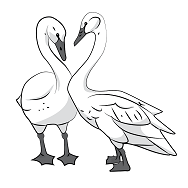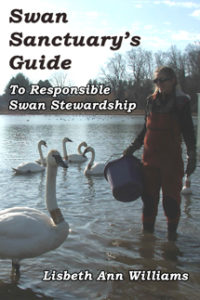Two swan species are indigenous to North America. They are the Trumpeter swan and the Tundra swan.
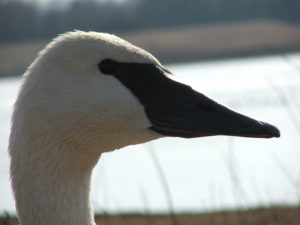
Cygnus buccinator
The Trumpeter Swan is the largest and most distinctive swan in North America. It is recognized by its loud, trumpeting call, and by its straight, black bill. It nearly disappeared due to over hunting in the early 1900’s, but a small group was recovered in Alaska and also around the Yellowstone area where they had escaped to safety. It is making a slow recovery thanks to organizations like The Trumpeter Swan Society that are dedicated to its re-introduction. Migration routes are passed on by parents to their offspring and although ultra-light experiments sought to re-establish these routes, they were unsuccessful. It is believed that some Trumpeters are now learning new migration routes from the Tundra Swans, with which they occasionally hybridize in the wild.
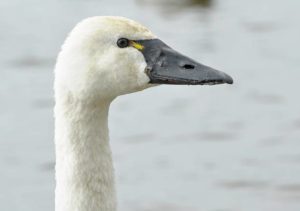
Cygnus columbianus
The Tundra Swan was formerly known as the Whistling Swan. It makes its annual migration of nearly 2,800 miles, from its breeding grounds in Alaska to its wintering grounds along the eastern and western seaboards. It is smaller than the Trumpeter Swan by about a third. It also has a black bill, but with a slight upward tilt and a small patch of yellow (called the lore) just below the eye. This marking can be highly individualized in size and shape, and it can occasionally be missing altogether. This swan’s vocalization is of a much higher pitch, produced while stretching the neck forward and up.
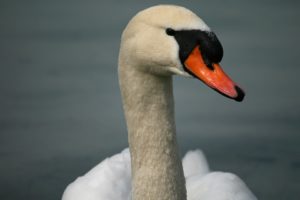
Cygnus olor
The Mute Swan is the swan most often seen in pictures and art and gracing public parks. It is recognized by the distinct black knob above a red-orange bill. It often holds its wings up and spread in a fan position over its back. The mother carries the cygnets (baby swans) on its back in this fashion. This posture is also used to show aggression. Although not actually mute, this swan has a much quieter call that sounds like a nasal snort. The Mute Swan is not indigenous to North America and has been classified as an invasive species. Owners of Mute Swans should not allow them to breed and they should be pinioned and confined in a fenced area to prevent their escape into the wild.
The remaining swan species can be found in other parts of the world and are generally seen only in zoos.
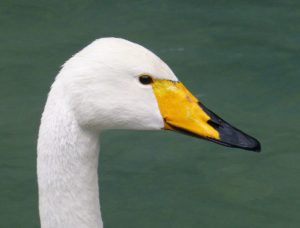
Cygnus cygnus
The Whooper Swan is the Eurasian version of our Trumpeter Swan. It is similar in size, but a large portion of its bill is yellow. Its call is loud and joyful and of a higher pitch than the Trumpeter Swan.
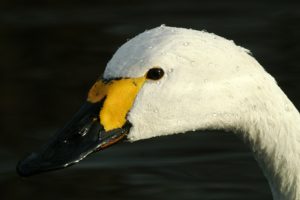
Cygnus bewickii
The Bewick Swan is a smaller version of the Whooper Swan, and by comparison, more similar to the North American Tundra Swan.
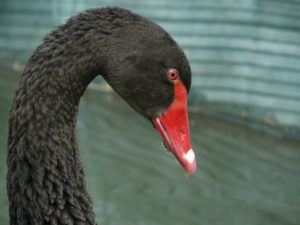
Cygnus atratus
The Black Swan gives allegiance to Australia, though it is often kept by private owners, and in zoos and parks, for their grace and beauty. They have a melodic song, a protruding knob, a bright red bill with a white ring near its tip, and white feathers on the underside of their black wings. Unlike other swan species, Black swans can breed at any time of the year. They are capable of producing up to four broods in one year.
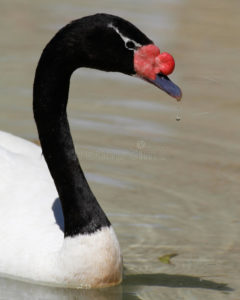
Cygnus melanocoryphus
Native to New Zealand, the Black-Necked Swan is dazzling to behold, due to the stark contrast between its jet black neck, and its white body and feathers. It is considerably smaller than the North American and the Eurasian swan species, boasting a bulbous red knob. The most beautiful and significant characteristic of this swan is its flute-like song. Neither the Black Swan nor the Black-Necked Swan is migratory.
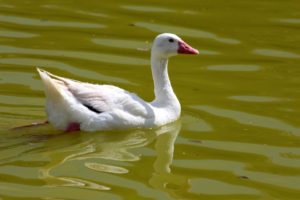
Coscoroba coscoroba
There has been in the past, some confusion as to classification of the Coscoroba Swan, native to South America. While it resides in the waterfowl family, Anatidae (ducks, swans, and geese) it is now placed in the sub-family of anserinae. It has been given its own genus, Coscoroba. Except for the black at the very tips of their primary feathers, that is more easily seen when they are in flight, they are dressed in pure white plumage. Their bill, legs and feet are bright orange-red.
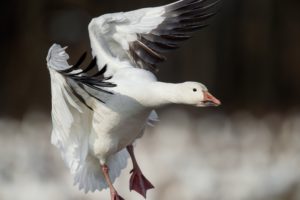
Anser caerulescens
The Snow Goose, which has one of the longest migration routes in North America, has lent some confusion to classification, as well. While it can often be mistaken for a swan from a distance, it is quite easy to distinguish the difference while they are in flight, due to the black wing tips, that look as though they were dipped into a bucket of black paint. Also, their bills are red-orange with black along the lower sides.

